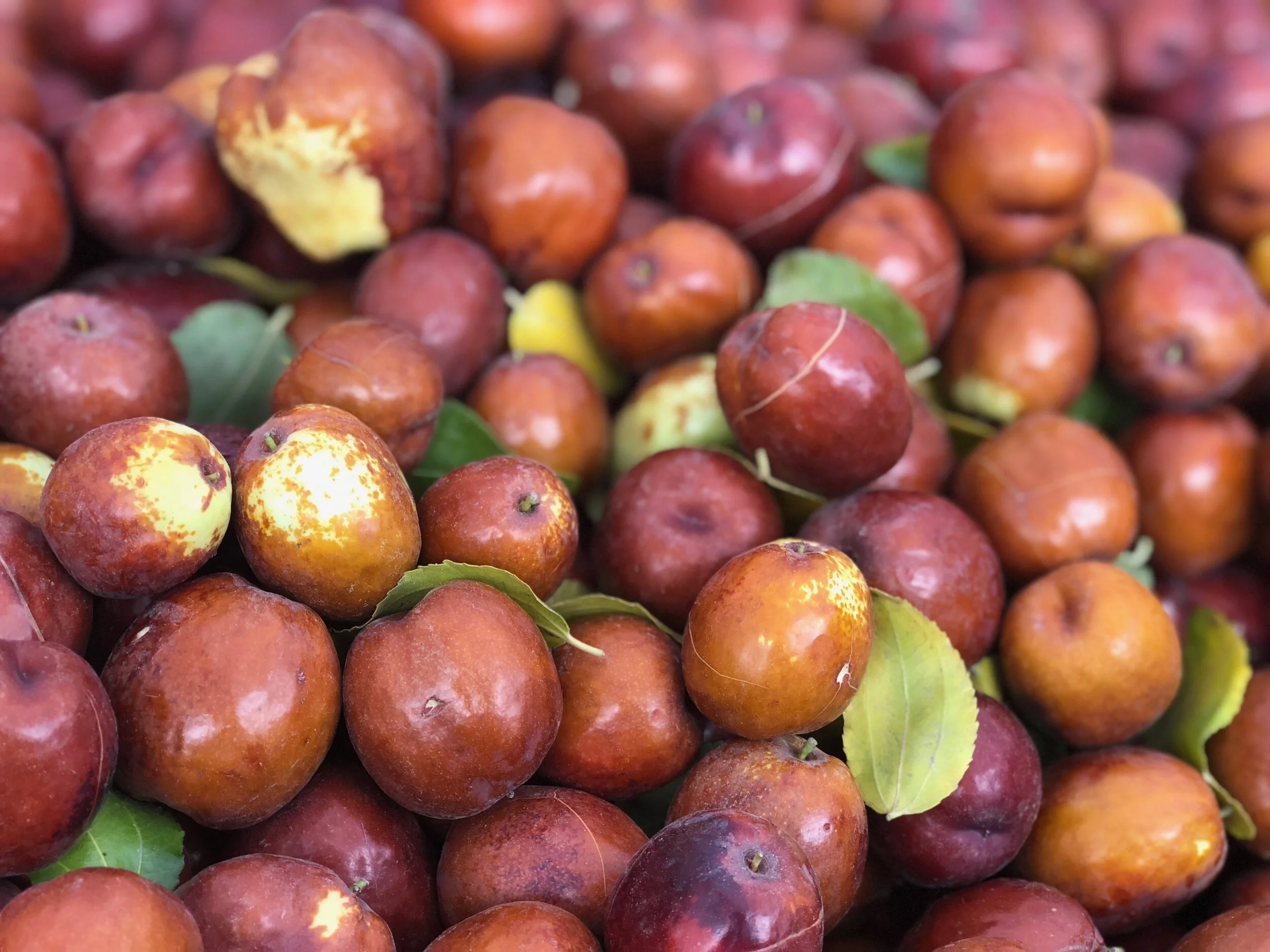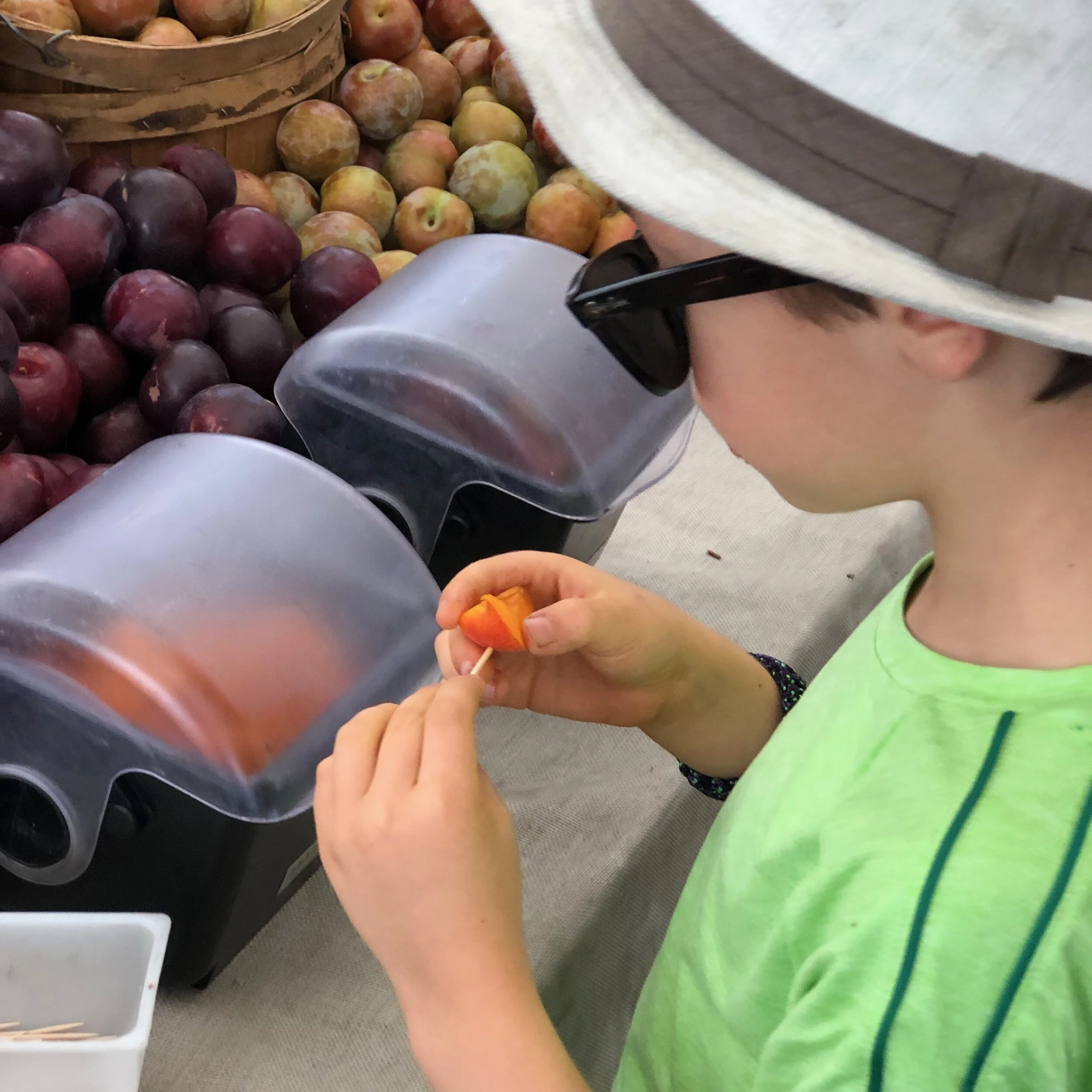Making Homemade Raisins
/Rather than throwing away old grapes, you can make them into homemade raisins. This is a great way to engage your kids around healthy food in the kitchen, by giving them something fun to make.
Read MoreRather than throwing away old grapes, you can make them into homemade raisins. This is a great way to engage your kids around healthy food in the kitchen, by giving them something fun to make.
Read MoreTu B’Shvat, the "birthday of the trees," celebrates the trees and fruits with which the Land of Israel is blessed. Celebrate this quirky holiday by making a homemade vegan charcuterie board.
Read MoreIt is a custom on Rosh Hashanah to eat new, seasonal fruits that have not been consumed since at least the year before. With so many exotic possibilities, how do you know which to choose? Here’s a guide to the most common new fruits.
Read MoreIf you are looking for a summer conversation starter, get a carton of Surinam cherries. Also known as pitanga, they are very high in Vitamins A & C.
Read MoreYou might have heard about the many health benefits of blueberries, too. In fact, a lot of nutritionists consider the blueberry to be a superfruit. Here are some fun ways enjoy blueberries.
Read More
blood oranges with Cara cara oranges
Have you ever thought about where your fruits come from and why they look the way they do?
Growing up in L.A., we mostly ate navel oranges. I can’t remember what other types we had, but they all looked the same: they were orange inside and out!
But my kids are more sophisticated with their fruits. They go through phases with their citrus. A few months ago, they were eating Satsuma mandarins by the boatload. Then Cara cara navel oranges. This month they are addicted to blood oranges. We have a whole drawer full of them in our fridge!
Today, we got curious. And this is what we discovered:
Blood oranges get their distinctly “bloody” maroon color from the high amount of anthocyanin polyphenols, which are antioxidants, common in many fruits like blueberries, raspberries and Concord grapes but very unusual in citrus. They are native to Italy and the Southern Mediterranean, where they have been cultivated since the 18th century.
What does a blood orange taste like? It tastes a bit like raspberry with a hint of tartness in addition to the orange flavor.
In addition to being divine when eaten by itself, it also goes well with sliced fennel, olive oil and a little apple cider vinegar.
What’s your favorite variety of orange? Leave a comment!

When you live in Los Angeles, you become spoiled by the enormous selection of fruits. There is hardly any fruit that is not grown in California in some capacity. Some, like the pomegranate, achieve wide exposure due to corporate marketing campaigns. Others remain artisan or exotic, quietly tucked away from the mainstream.
A persimmon is neither artisan nor exotic. But its unfamiliarity within the general population makes it enigmatic. To the uninitiated, it either resembles a plump tomato but with the wrong color; or it has the crunch of an apple but the taste of cinnamon and honey.
One you’ve tried one, though, you will be smitten. Just ask the Japanese. They made it their national fruit!

To add further confusion, there are two common varieties of persimmon, Fuyu and Hachiya. Unlike, say, apples, these persimmon varieties are vastly different from one other:

Resembles a cross between a tomato and a tiny pumpkin. When it is ripe, the texture is firm and crisp, like an apple. This variety is non-astringent.
Resembles a heart. It is not edible until it is very, very soft and jelly-like. The high tannin content in the unripe Hachiya gives it a harshly leathery, astringent taste. The sensation is similar to an unripe green banana or a very dry wine.
Even people who work in the grocery business may be unfamiliar with the Hachiya.
To illustrate:
I recently grabbed a handful of very soft and ripe Hachiya persimmons at Whole Foods. The woman at the checkout stopped me and remarked, “Oh no! Those are rotten. Let me get you some firm ones!” I responded, “No, you really don’t want to do that! They’re supposed to be soft.”
Nutritionally, persimmons are high in vitamin C and contain iron, calcium, potassium and manganese. They are also a reliable source of antioxidants such as vitamin-A, β-carotene, lycopene, lutein, zeaxanthin and cryptoxanthin, which may play a role in certain aging processes.
Aside from Whole Foods and some specialty markets, the best place to find persimmons is at farmer’s markets around the LA area. The growing season runs from mid-October to late December, although I am still seeing (and buying) them into January this year.
In addition to eating them fresh, dried persimmons also have several great uses:
As a dried snack for the kids to pack in their school lunches
In a salad, tossed into little pieces like dried cranberries
As an addition to a homemade trail mix
We like to use the pumpkin-colored Fuyu persimmons for this, as their drier, firmer texture makes them an ideal candidate for dehydration (or low-temperature oven drying). Hachiya persimmons are too astringent until they are very ripe, so these are best used in other recipes like a jam, pudding or smoothie.
Wash well (as you will be using the skin too; organic is best for this).
Slice thin using either a mandolin (manually) or a CuisineArt (we use a PowerBlend Duet). You can choose the thickness that you want for your slices. On the manual mandolin, we set ours to 1.3mm.
Lay out the slices on a wire mesh rack in a single layer.
Dehydrate at 145°F for 1 hour, then lower to 115°F for 6-8 hours (or until dry). If using an oven, set at the lowest temperature setting and leave the door ajar if you can. Depending on the oven, you will need to check the texture until the fruit feels dry to the touch.
Store in an airtight container like a Mason jar for up to 6 months.

AUTUMN ROYAL GRAPES
Beautiful Autumn Royal seedless table grapes. Flanked by Scarlet Royal at left and Princess at right.
With their deep purple hue, sweet taste and crisp texture, Autumn Royal are quite possibly our favorite grape variety this season. They make a remarkably tasty grape juice as well!
As one of the Seven Species, grapes hold a very special place in the Torah. But most commercial grape juices are made of Concord grapes. While the Concord’s presence at a Shabbat table is virtually the definition of traditional, the Autumn Royal delivers a new and exciting experience for us.
It’s always fun to experiment with making familiar juices from unfamiliar varieties. It’s even fun to combine them into blends! When you make your own grape juice, you get to decide on the flavors, textures and colors that you serve yourself and your family for special occasions such as Shabbat meals.
Want to learn how to make homemade grape juice? Try it!
These grapes were purchased from Nicholas Farms, which is located in Orange Cove, CA.

You may have seen these cute little fruits at farmer’s markets, Asian shops and Indian stores during the early autumn months. They’re jujubes, also known as red dates or Chinese dates. Jujubes resemble miniature ornamental apples when fully ripe, with their dappled brownish-yellowish skin and firm texture. Bite into one and you will find slightly spongy flesh with a date-like pit at the center.
Unlike the popular candy of the same name, which has absolutely no nutritional value, the jujube fruit is a nutritional powerhouse. It contains lots of fiber and is high in vitamins A and C, the B vitamins, iron, phosphorus and calcium.
Jujubes have been cultivated for over 4,000 years and are employed heavily in Chinese medicine. They are used for combatting insomnia and pain, as well as for their sedative effects. Of course, they can be taken in supplement form – but they’re certainly more delicious in their natural form!
I love sending jujubes to school with my kids, as they become little jujube addicts during snack time. The anti-anxiety and pro-digestive effects alone make it a worthwhile treat!
Besides popping jujubes into your mouth like gum balls, what are its culinary possibilities? Here is a sampling of ideas:
Boil into a tea
Dehydrate into dried fruit
Dry and use in place of dates or raisins
Dry, chop up and mix with almonds, walnuts and other nuts as a trail mix

Now that the stone fruit season is winding down, I want to pay homage to one of my favorites: pluots. Have you noticed these colorful-looking stone fruits at the farmer’s markets – and even at Trader Joe’s? Pluots are hybridized stone fruits that are roughly 75% plum and 25% apricot. They are a relative newcomer, having been developed in the late 1980s. What I love about their plum-like flavor is that they rarely exhibit the characteristic tartness of plums. Instead, they explode with sweetness. Nutritionally, they are very rich in vitamin C and potassium.
I grew up eating a handful of stone fruits: plums, apricots, peaches and nectarines. That was the extent of it, and in retrospect it seems so boring!
By contrast, pluots come in dozens of varieties and a multitude of colors such as green, crimson, purple, orange and pink. My kids are most intrigued by their colorful names, which match their colorful skins: Dapple Dandy, Dinosaur Egg, Emerald Beauty, Flavor Grenade, Flavor Treat, Flavor Queen, Honey Punch, Crimson Beauty, Crimson Royale and Splash, among many others that we’ve tried. Each of my kids has a personal favorite.

For now, we must be content with finishing our last remaining pluots of the season, until the late-spring pluot harvest comes around again.

Kosher food can be both tasty and nutritious. It need not be filled with cheap refined carbs, sugar, salt, preservatives or filler. The purpose of Consciously Kosher is to teach people how to eat a kosher diet rich in nutritious, predominantly unprocessed whole foods. The recipes and meal hacks are simple and quick, to accommodate parents juggling careers and multiple kids.
Articles | Nutrition | Health & Wellness | Recipes | Workshops
Consciously Kosher © 2023 Michael Tanenbaum